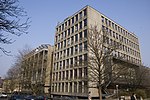St Paul's Church, Clifton, Bristol
St Paul's Church, on St Paul's Road, Clifton, is an Anglican parish church and was formerly the University of Bristol Church, in the City Deanery of the Diocese of Bristol. The church is one of two in the Benefice of St Paul's and Cotham, David Stephenson, inducted as vicar of the Benefice in 2018, is the current incumbent. The current building largely dates from 1867, when it was rebuilt following a fire, using a variety of stones. The architect was Charles Hansom, who lived locally at the time, following his work on Clifton College. Hansom was able to retain the tower and spire by Manners and Gill from the original building. The church is listed Grade II and is notable for its stained glass windows and mosaics lining the walls, and especially the reredos. In March 2012 the church was awarded a grant from English Heritage to repair the roof. A major factor in this, according to English Heritage, is that the mosaics and windows are of national importance.
Excerpt from the Wikipedia article St Paul's Church, Clifton, Bristol (License: CC BY-SA 3.0, Authors).St Paul's Church, Clifton, Bristol
Oakfield Place, Bristol Clifton Village
Geographical coordinates (GPS) Address External links Nearby Places Show on map
Geographical coordinates (GPS)
| Latitude | Longitude |
|---|---|
| N 51.4591 ° | E -2.6113 ° |
Address
St. Paul's Church
Oakfield Place
BS8 1LR Bristol, Clifton Village
England, United Kingdom
Open on Google Maps








